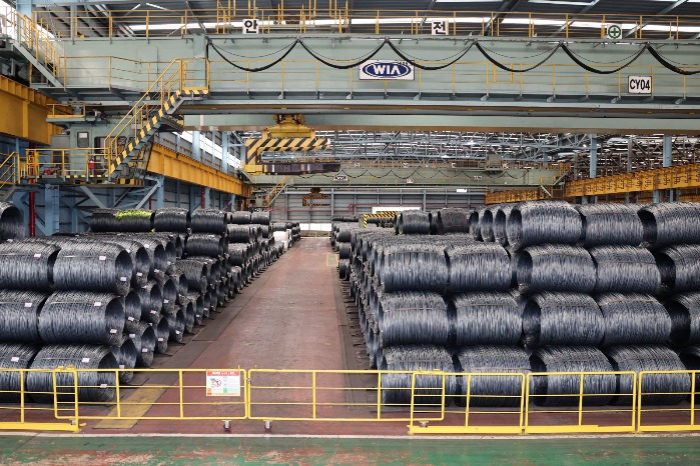Steel
POSCO gains huge dividend from Roy Hill mine in H1
The Korean steel giant earned the $112.9 million dividend from its investment in the Australian mine as iron ore prices rose
By Aug 18, 2022 (Gmt+09:00)
2
Min read
Most Read
S.Korea's LS Materials set to boost earnings ahead of IPO process


Samsung shifts to emergency mode with 6-day work week for executives


NPS to commit $1.1 billion to external managers in 2024


HD Hyundai Marine IPO sees strong demand from retail investors


Navigating choppy waters: Dollar-won FX forecasting ┬Ā



When South KoreaŌĆÖs leading steelmaker POSCO Group acquired a 12.5% stake in AustraliaŌĆÖs Roy Hill mine for 1.52 trillion won ($1.2 billion) in 2010, the steelmaker faced harsh criticism from its stakeholders as the prices of iron ore, a key material for steel, were fluctuating.
The shareholdersŌĆÖ perspectives have changed in recent years. Alongside increasing iron ore prices, POSCO Group has gained an aggregate 785.6 billion won in dividends since 2020.
According to KoreaŌĆÖs Financial Supervisory Service on Thursday, the steelmakerŌĆÖs holding company POSCO Holdings Inc. collected a 148.6 billion won dividend in the first half of 2022 from Roy Hill Holding Pty Ltd., the mine operator. The first dividend paid out to POSCO Holdings was 114 billion won in 2020, followed by 523 billion won in 2021. ┬Ā┬Ā┬Ā
Roy Hill is the largest single mine located in the Pilbara region of Northwest Australia. It has an iron ore reserve of 2.3 billion tons and an annual output of 55 million tons. Gina Rinehart, executive chairman of Australian mining company Hancock Prospecting Pty Ltd. started developing Roy Hill in 1992.
In addition to POSCO, Roy Hill HoldingsŌĆÖ shareholders include Hancock Prospecting with a 70% stake, JapanŌĆÖs Marubeni Corp. with 15% and TaiwanŌĆÖs China Steel Corp. with a 2.5% stake.
After POSCO bought the shares in Roy Hill, the global iron ore price soared to around $200 per ton in the 2010s and nosedived to $38 in December 2015. Despite┬Ā investor criticism, POSCO decided to hold the stake for a stable supply chain of raw materials.┬Ā┬Ā┬Ā
After the mine started producing in 2015, it achieved its target to annually produce 550 million tons of iron ore in 2018. In 2019, Roy Hill Holdings posted 1.64 trillion won of net profit as the raw material price recovered to $120 per ton.
Skyrocketing to over $210 per ton in July 2021, iron ore prices have come down to around $110 this August, according to Markets Insider.
Roy Hill Holdings reported 2.3 trillion won and 3.74 trillion won net profits in 2020 and 2021, respectively, as iron ore prices soared. Its first-half net profit this year reached 1.37 trillion won, increasing its dividends to shareholders.┬Ā ┬Ā
POSCO bought 210.4 billion won worth of iron ore from Roy Hill Holdings in the first half alone. The Korean steelmaker is striving to improve its procurement chain of iron ore, raising the self-sufficiency rate from the 10% range in the early 2010s to the current 40% range.
The steelmaker is also making efforts to secure secondary battery materials via a strengthened partnership with Hancock.
In June, POSCO and Hancock signed a memorandum of understanding to develop mines of lithium, nickel, copper and iron ore in Australia. The MOU also included the two partiesŌĆÖ cooperation in producing hot briquetted iron (HBI) used in electric arc furnaces to make steel.┬Ā ┬Ā┬Ā
Write to Ik-Hwan Kim at lovepen@hankyung.com
Jihyun Kim edited this article.
More to Read
-
 SteelPOSCO, Krakatau to expand Indonesia steel mill for $3.5 bn
SteelPOSCO, Krakatau to expand Indonesia steel mill for $3.5 bnJul 28, 2022 (Gmt+09:00)
2 Min read -
 EarningsPOSCO Holdings Q2 profit down on higher raw material costs
EarningsPOSCO Holdings Q2 profit down on higher raw material costsJul 21, 2022 (Gmt+09:00)
2 Min read -

-

-

Comment 0
LOG IN


